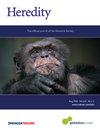非洲和欧洲牛群的全基因组地方祖先和混血的功能性后果。
IF 3.9
2区 生物学
Q2 ECOLOGY
引用次数: 0
摘要
牛(牛磺酸牛)和牛(籼米牛)至少在 15 万年前分化,从那时起,这两个牛系之间的基因组就出现了巨大差异。在过去的两千年中,非洲的基因交流产生了复杂的金牛-籼牛血统,大多数牛群都表现出不同程度的混血。同样,南欧的一些牛群也显示出来自籼牛历史基因流的证据,其中中意白种牛的基因流水平最高。在这里,我们使用了两种不同的软件工具(MOSAIC 和 ELAI),通过全基因组高密度和低密度 SNP 阵列数据集对非洲杂交牛和南欧残留混血牛进行了本地祖先推断(LAI),尽管使用的两种 LAI 方法存在重大差异,但我们还是得到了大致相似的结果。我们的分析确定了非洲金牛、欧洲金牛和亚洲籼牛血统保留或引入祖先水平较高的基因组区域。这些祖先峰基因的功能富集突显了与免疫生物学和嗅觉有关的生物过程,其中一些过程可能与对传染病的不同易感性有关,包括牛结核病、东海岸热和热带牛瘟。值得注意的是,对于混血锥虫病耐受牛中保留的非洲牛血统,我们观察到与血红蛋白和氧运输相关的基因富集。这可能反映了基因组变异的正向选择,这些变异增强了对严重贫血症的控制,而严重贫血症是锥虫病的一个衰弱特征,严重制约了撒哈拉以南非洲大部分地区的养牛业。本文章由计算机程序翻译,如有差异,请以英文原文为准。

Genome-wide local ancestry and the functional consequences of admixture in African and European cattle populations
Bos taurus (taurine) and Bos indicus (indicine) cattle diverged at least 150,000 years ago and, since that time, substantial genomic differences have evolved between the two lineages. During the last two millennia, genetic exchange in Africa has resulted in a complex tapestry of taurine-indicine ancestry, with most cattle populations exhibiting varying levels of admixture. Similarly, there are several Southern European cattle populations that also show evidence for historical gene flow from indicine cattle, the highest levels of which are found in the Central Italian White breeds. Here we use two different software tools (MOSAIC and ELAI) for local ancestry inference (LAI) with genome-wide high- and low-density SNP array data sets in hybrid African and residually admixed Southern European cattle populations and obtained broadly similar results despite critical differences in the two LAI methodologies used. Our analyses identified genomic regions with elevated levels of retained or introgressed ancestry from the African taurine, European taurine, and Asian indicine lineages. Functional enrichment of genes underlying these ancestry peaks highlighted biological processes relating to immunobiology and olfaction, some of which may relate to differing susceptibilities to infectious diseases, including bovine tuberculosis, East Coast fever, and tropical theileriosis. Notably, for retained African taurine ancestry in admixed trypanotolerant cattle we observed enrichment of genes associated with haemoglobin and oxygen transport. This may reflect positive selection of genomic variants that enhance control of severe anaemia, a debilitating feature of trypanosomiasis disease, which severely constrains cattle agriculture across much of sub-Saharan Africa.
求助全文
通过发布文献求助,成功后即可免费获取论文全文。
去求助
来源期刊

Heredity
生物-进化生物学
CiteScore
7.50
自引率
2.60%
发文量
84
审稿时长
4-8 weeks
期刊介绍:
Heredity is the official journal of the Genetics Society. It covers a broad range of topics within the field of genetics and therefore papers must address conceptual or applied issues of interest to the journal''s wide readership
 求助内容:
求助内容: 应助结果提醒方式:
应助结果提醒方式:


